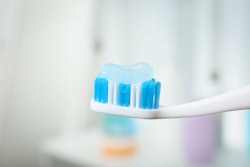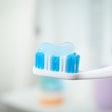One of the most common questions from patients recently is "Should I be using fluoride or hydroxyapatite?" The increased attention on ingredient transparency, "natural" solutions, and wellness culture has pushed us to communicate more intentionally about what we recommend and why.

It's not about fluoride versus hydroxyapatite. It's about understanding function, science, and how we educate patients without creating confusion.
Topical fluoride vs. systemic fluoride: A quick reframe
Fluoride works. That’s not a marketing line; it's an evidence-based statement. But how it works matters when we’re explaining it to patients.
Systemic fluoride, like what we get from fluoridated water or supplements, is most effective during tooth development. It helps build stronger enamel from the inside out.
Topical fluoride (varnishes, pastes, rinses) is where most of our prevention efforts are focused for patients of all ages. It works on erupted teeth to remineralize early lesions and inhibit bacterial metabolism.
And, importantly, topical fluoride has proven antimicrobial benefits, especially against Streptococcus mutans. This is where the conversation often stops short. When a patient asks about fluoride, it’s not just about remineralization. It's about reducing the bacterial load in high-risk patients.
Beyond remineralization: The role of antimicrobial agents
When we’re talking about caries prevention, we can't isolate it to remineralization alone. While rebuilding enamel is a foundational part of preventive care, it only addresses part of the picture. The oral microbiome -- particularly pathogenic bacteria -- must also be managed to create a stable environment for long-term health.
This is where antimicrobial strategies come in. Topical fluoride not only aids in demineralization, but it also inhibits bacterial metabolism, making it uniquely positioned as a dual-action agent.
In moderate-to-high-risk patients, additional antimicrobial intervention may be necessary. Remineralization is critical, but it’s only half the story. True prevention includes managing the microbial landscape, and in many cases, varnishes provide the extended, targeted approach that brushing and rinsing simply cannot.
Why varnishes are different from rinses
Let’s start with the basics: What is a varnish? A varnish is a professionally applied topical treatment that adheres to the tooth surface and slowly releases active ingredients over time. It allows for more controlled and extended therapeutic effects compared to rinses, which are diluted quickly and rely on daily compliance.
This distinction is especially important when comparing short-term and long-term benefits. Rinses can support short-term microbial reduction or enamel strengthening, but they require consistent use. They are helpful for daily maintenance, yet their therapeutic window is limited.
In contrast, varnishes deliver a sustained, localized effect. Varnishes adhere to the teeth and soft tissues and slowly release active ingredients, making them ideal for high-risk patients such as those with xerostomia, root caries, or difficulty managing plaque.
Unlike rinses, varnishes are not dependent on patient compliance and are less likely to cause side effects such as staining or altered taste. This is particularly true for chlorhexidine varnishes, which provide prolonged antimicrobial action without the common drawbacks of daily rinses.
In short, varnishes provide professional precision and long-term protection, supplementing daily hygiene routines where additional support is needed. They are not replacements for home care, but they are an essential tool in our preventive and therapeutic strategies.
Nano-hydroxyapatite: When it works and when it doesn’t
Nano-hydroxyapatite (nHA) is getting a lot of buzz, and for good reason. It's biomimetic, biocompatible, and helps rebuild enamel on a microscopic level. But the truth is, it requires a specific oral environment in which to work. Here's what needs to be present:
- A neutral to slightly acidic pH (ideally 6 to 7)
- Adequate salivary flow for ion transport
- A relatively clean tooth surface to allow for particle adhesion
That’s not the reality for many of our patients. Patients with dry mouth, poor hygiene, acidic diets, or active disease will not see the same benefits.
Unlike fluoride, nHA has a less than a desirable antimicrobial impact by itself. It does not suppress bacterial acid production or impact the biofilm in the way fluoride does.
It’s also important to note that not all nHA products are the same. There’s no standardized concentration or delivery method across brands, which makes it harder to predict outcomes.
What do we tell our patients?
Here’s the key: We listen first. When a patient questions fluoride or asks about "natural" options, it’s not a rejection of science, it’s a call for understanding. Our role isn’t to convince but to guide, to meet patients where they are and to match their risk level and preferences with the right solution.
For a patient who is low-risk, highly motivated, and consistent with their oral hygiene routine, recommending an nHA toothpaste might be appropriate. These individuals are often looking for fluoride alternatives, and if the rest of their oral environment supports it -- a neutral pH, healthy salivary flow, low plaque levels -- nHA can provide surface-level enamel support.
However, many of our patients are not operating within ideal oral conditions. For patients with a high caries risk, compromised salivary function, inconsistent oral hygiene, or active disease, fluoride varnishes and high-strength professional fluoride products remain essential. These patients benefit from targeted, sustained fluoride delivery that only professional application can ensure.
When patients are concerned about fluoride but present with active caries or enamel breakdown, we can explain that this isn't an either/or situation. Adjunctive therapies like chlorhexidine and thymol varnishes (like Cervitec Plus from Ivoclar) can serve as interim steps while building trust. Some patients may benefit from a combined approach using both fluoride and hydroxyapatite under professional guidance.
Ultimately, the conversation isn’t solely about ingredients. It’s about context, compliance, and clinical outcomes. We do more than recommend -- we assess, interpret, and tailor interventions to help our patients thrive. This isn't about choosing sides, it's about choosing what works best for each patient.
As oral health professionals, we sit at the intersection of evidence, empathy, and education. That means offering personalized, science-backed care that adapts to the person in front of us, not just their mouth but their values, concerns, and lifestyle.
When we engage in these conversations, we’re not defending products, we’re empowering patients with clarity. And that clarity comes from being transparent about what each treatment can and cannot do without judgment.
Kelly Tanner, PhD, RDH, is a contributing author to DrBicuspid, where she shares insights and strategies to empower dental hygienists in their careers. As a leader in clinical training, professional development, and team dynamics, Tanner provides resources to help hygienists elevate their practice and personal growth. For further support, join her free Facebook group Next Level Dental Hygiene Career and Personal Development, and explore group training and on-demand courses at www.nextleveldentalhygiene.com.
The comments and observations expressed herein do not necessarily reflect the opinions of DrBicuspid.com, nor should they be construed as an endorsement or admonishment of any particular idea, vendor, or organization.




















